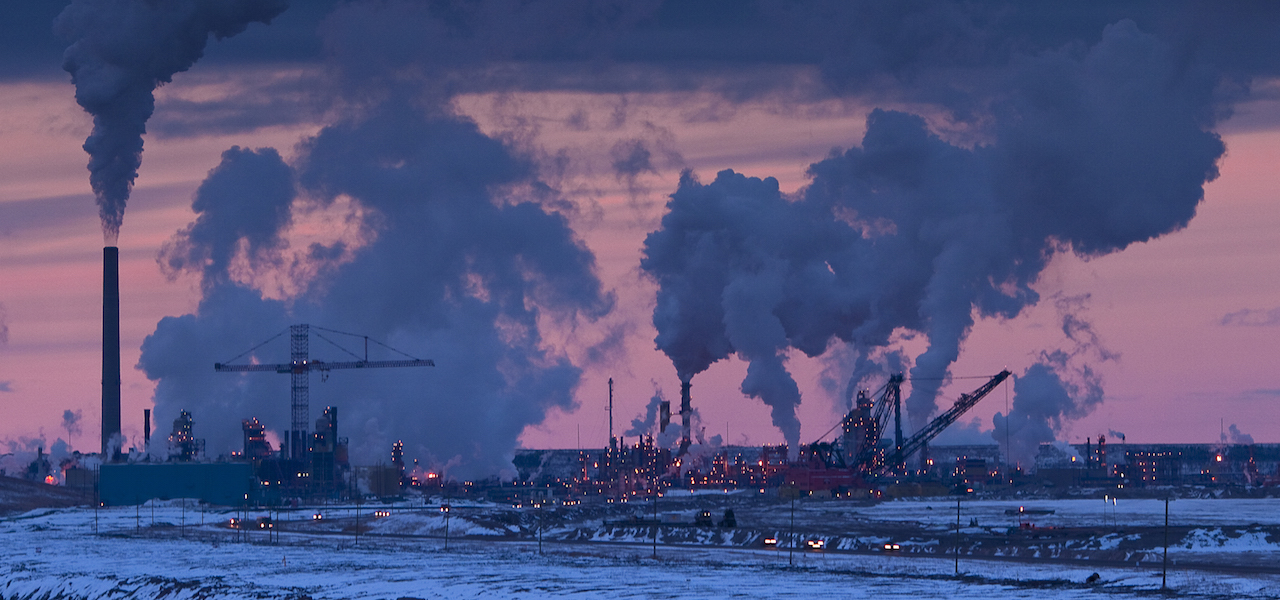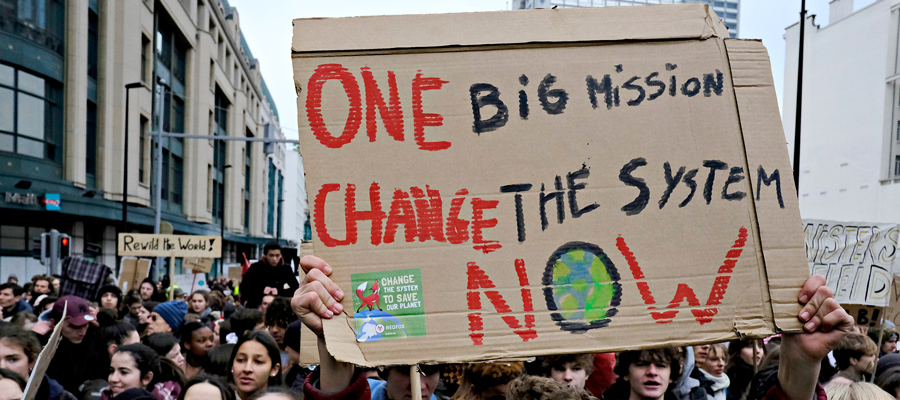New federal climate plan hindered by commitment to fossil fuel production

Five years after the negotiation of the Paris agreement, the federal government is finally starting to walk the talk on climate change.
Canada’s updated climate action plan, released December 11, is the most serious piece of climate policy we’ve yet seen from this government. It comes alongside new measures announced by 70 other governments as part of a virtual climate summit held last week and it puts some meat on the bones of Canada’s recent commitment to net-zero emissions by 2050.
Canada’s new plan builds on the Pan-Canadian Framework on Clean Growth and Climate Change (PCF), negotiated by the feds, provinces and territories in 2016. That framework brought in a national carbon pricing floor rising to $50 per tonne in 2022 (about 11 cents per litre of gasoline), the accelerated phase out of coal-fired electricity generation, a clean fuel standard (still in development) and a long list of initiatives and incentive programs.
Whereas the old plan sought buy-in from all levels of government, the updated plan is focused on meeting Canada’s Paris pledge—a reduction in greenhouse gas (GHG) emissions to 30% below 2005 levels by 2030—through federal measures alone. According to the feds, the new plan is expected to put Canada on track to exceed its 2030 target (although with an asterisk or two as we discuss below). Any additional climate policies brought in by the provinces and territories in areas of their jurisdiction will allow Canada to meet the target faster and/or exceed it even further.
Too often climate plans leave a big emissions gap to be addressed through “additional measures” by future governments, so the fact that the new plan offers a complete strategy for meeting the country’s targets matters. Unfortunately, the plan’s promise is undermined by a continued commitment to expanding fossil fuel production, and too few hard commitments to end carbon polluting technologies and practices.
Let’s break it down.
Ratcheting up the carbon price
The part of the plan attracting the most attention is a commitment to ramp up the national carbon pricing floor—the minimum standard for all provinces and territories. This is the boldest and most ambitious policy in the federal plan, especially given the politically challenging politics of carbon pricing in Canada.
Under the new plan, the carbon price will not be frozen at $50/tonne in 2022 as initially proposed but instead will rise by $15/tonne per year starting in 2023, until it reaches $170 in 2030. A rising carbon price incentivizes the market to shift away from high-emitting fossil fuels toward lower-emitting options, like renewable energy and electric vehicles, and provides greater certainty to those planning long-term investments such as provincial energy utilities and corporate investors.
The federal government remains stubbornly committed to a revenue-neutral pricing system, which means it will continue to rebate all revenues raised by the carbon price to households, businesses and communities (more on this below). These rebates help ensure that lower-income households aren’t hit harder by the increased price of fuel and certain consumer goods. In fact, the majority of Canadian households are financially better off under the tax and rebate system than without it (a family of four in Saskatchewan can expect cheques worth as much as $3,829 per year by 2030). Rebates will now be provided quarterly, rather than annually, which may help increase political support for the policy.
However, a few notes of caution on carbon pricing are warranted.
Under the new plan, the carbon price will not be frozen at $50/tonne in 2022 as initially proposed but instead will rise by $15/tonne per year starting in 2023.
First, a Supreme Court challenge to the federal carbon pricing backstop is still pending. Perhaps for this reason, Environment Minister Wilkinson called the new plan a “proposal” to be discussed with the provinces and territories.
Second, many major industrial emitters are not fully covered by the pricing system. Certain industries are covered instead by the federal output-based pricing system (OBPS), which applies a carbon price only to emissions above a certain threshold. The OBPS is ostensibly intended to preserve “competitiveness,” but ultimately serves as an excuse for heavy emitters to decarbonize slower than the rest of the economy.
Third, the tricky politics of carbon pricing combined with the federal government’s commitment to revenue neutrality have produced a system where all the money collected under the federal carbon pricing backstop is returned to the province where emissions originate. This compromise with obstinate provincial governments is a huge missed opportunity for federal climate action because a large share of those revenues could be better spent on additional emission reduction initiatives, such as a permanent public transit fund. In total, the new federal plan promises $15 billion in new money, none of which is funded by the carbon tax—a natural revenue source—and will instead provoke familiar criticisms about where the money is going to come from to pay for these climate measures.
On a positive note, the new plan entertains a border tax adjustment to compensate for inadequate carbon pricing on imported goods. The European Union is moving ahead with a similar system and the Biden administration has signalled its interest in carbon tariffs, so Canada may be able to collaborate with these key trading partners on a more climate-friendly international trading system.
Lots of incentives, too few stronger regulations
Like the 2016 PCF, the new federal climate plan is loaded with incentive programs aimed at shifting spending patterns, but it falls short on concrete measures to directly regulate major sources of carbon pollution.
For example, the new plan extends consumer subsidies to reduce the cost of buying a zero-emission vehicle (ZEV), but it doesn’t include a mandate to phase-out or ban internal combustion engine (ICE) vehicles. Provinces like BC have led the way with a commitment to 30% of vehicle sales being zero-emission by 2030 and 100% by 2040. Some countries, like Norway, the Netherlands and the UK, have gone further still.
Transportation accounts for a quarter of Canada’s GHG emissions—it is the second largest source after oil and gas production—so incentives won’t go far enough to clean up our roads. Even as ZEVs become more commonplace, millions of new ICE cars will be purchased over the coming decade unless strong regulatory action prevents it. Canada could do much more to drive the marketplace for ZEVs but generally seems content to follow the US lead (by aligning vehicle emission standards with Biden or California) in the interests of corporate harmonization.
Similarly, in the building sector the government has opted for another round of incentives (up to $5,000 per household for investments in energy efficiency and fuel switching) rather than clear bans on the use of fossil fuels for energy. Like the ZEV incentives, these subsidies tend to benefit already affluent households and don’t do enough to discourage continued investment in fossil fuel infrastructure.
Some other important measures include almost $1 billion for renewable energy and electricity grid modernization and $300 million for getting rural and remote indigenous communities off of diesel. But these amounts fall far short of what is needed to truly decarbonize our energy system.
Failure to address the supply of fossil fuels
Where the plan falls dangerously short is on fossil fuel production. Despite the federal government’s genuine efforts to reduce the use of fossil fuels domestically, it remains unwavering in its support of oil and gas for export. Countries like Denmark, France and New Zealand are calling for an end to oil and gas exploration now and an end to all oil and gas production by mid-century. In contrast, the baseline for Canada’s new plan is a 20% increase in oil production and a 17% increase in gas production, neither of which peak until 2039.
The Canadian plan does propose a national infrastructure assessment to identify and plan for long-term needs, but it ignores the short-term imperative of ensuring that major infrastructure projects on the table pass a test of climate compatibility. The plan makes no mention of the Trans Mountain Expansion pipeline, the Keystone XL pipeline or LNG Canada, for example, each of which would facilitate huge amounts of greenhouse gas emissions into the global atmosphere.
If Canada was responsible for all the carbon extracted here but burned elsewhere, our contribution to global climate change would be twice as high as we claim.
Unfortunately, the updated climate plan proposes a variety of measures that aim to extend the era of fossil fuels, including new supports for carbon capture and storage (CCS) technologies and hydrogen fuels. CCS has long been an industry darling, but the reality is that capturing carbon and piping it underground for long-term storage is more fantasy than reality. In practice, many CCS projects are used to repressurize old wells to get more oil and gas out of them—not to permanently store CO2—and, even if CCS someday realizes its promised potential, there are not vast empty underground reservoirs into which we can easily dump our waste carbon. Scale and cost limit the viability of CCS.
The baseline for the new plan is a 20% increase in oil production and a 17% increase in gas production, neither of which peak until 2039.
Hydrogen fuels have been a recent gleam in the eye of fossil fuel producers who see them as a new lease on life for the industry. While there are important niches for hydrogen (such as steelmaking and other industrial processes), Canada can produce clean hydrogen from renewable sources without requiring fossil fuels at all.
Nonetheless, a national hydrogen strategy is in the works and the federal climate plan provides a $1.5 billion Low-carbon and Zero-emissions Fuels Fund to “increase the production and use of low-carbon fuels” such as “hydrogen, biocrude, renewable natural gas and diesel, cellulosic ethanol” that are not compatible with a zero-carbon economy.
To make matters worse, the plan includes a number of potential new fossil fuel subsidies, including a $3 billion Net Zero Accelerator program and a $750 million Emissions Reduction Fund. In addition, proceeds from the OBPS will go toward industrial projects. Although it is not clear how much of this money will go toward fossil fuel companies specifically, some oil and gas projects will undoubtedly be receiving new government support at precisely the moment when we should be phasing them out.
With this plan, the federal government continues to skirt around the inevitability of a global transition away from fossil fuels. To truly be a climate leader, Canada needs to start talking about a managed wind-down of fossil fuel production. Getting ahead of the curve will allow Canada to manage the transition in a way that is measured, predictable and just. Proceeding as if the rest of the world won’t get off fossil fuels is a recipe for future disruption that will inevitably hit workers, communities and the broader economy much harder.
Dodgy accounting?
The federal government claims the new plan will allow Canada to not just meet but exceed its 2030 emissions target. Although it appears possible given the details outlined in the plan, there is some cause to be wary.
First, one-third of the plan’s emission reductions come from the oil and gas sector despite no commitment to regulate or reduce total oil and gas production. The plan does not specify where these reductions will come from, but we suspect the government’s analysis relies on a reduction in methane emissions from the fossil fuel production process, potentially through the application of stricter methane regulations to certain pieces of equipment.
There is no clear baseline for current industrial methane emissions. Although the industry does self-report, independent assessments have generally found the amount of methane leaking from fossil fuel infrastructure to be much higher. Consequently, the extent of absolute reductions over the full extraction process is difficult to reliably measure.
Second, the Federal Greenhouse Gas Offset System is a potential get-out-of-jail-free card for heavy industrial emitters because it allows them to purchase credits from other emissions-reduction initiatives rather than reducing emissions themselves. Canada has long been attracted to “solutions” that do not require the country to fundamentally change how it does business. Offsets have long been criticized for supporting initiatives that would have happened anyway or that do not provide durable, long-term emission reductions.
Third, the inclusion of “nature-based solutions” in the new plan introduces a similar hazard. The plan counts on some 27 megatonnes of GHG reductions from tree planting and related initiatives. Although intrinsically important, measures to protect and enhance natural carbon sinks should not be counted on to substitute for climate policies that reduce emissions from fossil fuels in absolute terms.
These loopholes are especially important as we consider the goal of net-zero emissions by 2050. A plan that relies on offsets, nature-based solutions and denial about the future of export markets is not a full plan—too much “net” and not enough “zero”.
Next steps
With this updated federal climate plan, Canada has put the building blocks in place for more aggressive emissions reductions than we’ve seen before. However, there is much more work to be done. In many respects, Canada has now merely caught up to our previous—and inadequate—2030 promise, but we have not taken the lead by any stretch of the imagination.
While $15 billion in new funding for climate action sounds significant, it is spread over the next decade and only amounts to a fraction of a percentage point of GDP. If we raised our climate spending to 2% of GDP—the level recommended by former World Bank chief economist Nicholas Stern—we should be committing at least $40 billion every year to mitigating and adapting to the climate crisis. This is where carbon pricing revenues have the potential to play a defining role in driving Canada’s transformational shift to a zero-carbon economy.
The next move lies with the provinces and territories that will now feel the pressure to increase their climate policy ambitions. Canada is required to submit a new and more ambitious GHG emissions reduction target to the United Nations Framework Convention on Climate Change next year as part of the Paris Agreement (called a National Determined Contribution). After years of slow movement, this coming year will be pivotal for all governments in Canada to put our economies on a pathway to a clean energy future.
This post is part of the Corporate Mapping Project, a research and public engagement project investigating the power of the fossil fuel industry in Western Canada, led by the University of Victoria, the Canadian Centre for Policy Alternatives (BC and Saskatchewan Offices) and Parkland Institute. This research is supported by the Social Science and Humanities Research Council of Canada (SSHRC) and the Minor Foundation for Major Challenges.
Topics: Climate change & energy policy



